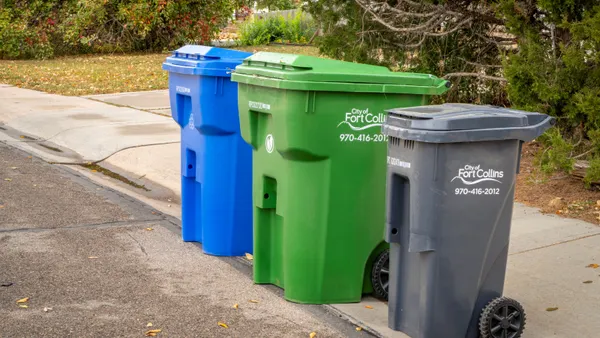Dive Brief:
- Jefferson County, KY, (home to Louisville) had an overall diversion rate of around 49% in 2015, diverting 832,000 tons of material from landfill, according to a solid waste study published by the city of Louisville.
- Sectors had a variety of diversion rates; for example, C&D had an 81% diversion rate while residential had only an 18% diversion rate. Louisville has a goal of reaching 90% diversion and 90% consumer participation by 2042.
- Currently, Jefferson County has a residential participation rate of around 30%, as reported by WFPL. Recycling in the county is opt-in. The solid waste study makes three recommendations to hit its diversion goals: Developing service standards, adopting enforceable ordinances and contracts, and running education and marketing campaigns.
Dive Insight:
In addition to being opt-in, recycling in Jefferson County is handled by a myriad of municipalities and homeowner associations. Not only can recycling be costly for individual households, it can be complicated — those complexities even rose to a back-and-forth between the county and state lawmakers last year.
The newly-released solid waste study appears to appreciate those complexities more than city lawmakers. The Sustain Louisville plan, originally released in 2013, called for a 90% participation rate by 2025, a number that now seems unachievable.
However, the 10-year plan also presents opportunity. Residents disposed around 310,000 tons of waste that was otherwise recoverable in 2015. Around 36% of that was, at the time, already recoverable through curbside, drop-off or yard waste compost programs, according to the study.
The study therefore recommends capturing these already divertable waste streams through outreach, marketing and education programs over 10 years, which the study predicts will reduce source-based waste by 1,700 tons by 2026. Similar campaigns for the industrial, commercial and institutional sectors could divert nearly 9,000 more tons annually.
In totality, the study thinks its 10-year plan could increase diversion from 49% to 58%, representing more than 1 million tons annually, with an estimated cost of $7.5 million spread over ten years. The plan, however, is not final, and takes Louisville Metro to a "decision point" in 2026 where local officials will need to reassess the program for efficacy.








